Over 310 million people shop on Amazon, with more than 12 million products sold daily and 250 million Prime members worldwide.
As the largest e-commerce platform in the U.S. with a 37.6% market share, Amazon’s reach is unmatched. From seller growth to revenue and Prime Day milestones, this article breaks down all the key Amazon statistics you need to know in 2025.
Amazon Statistics: Top Picks
- Over 310 million people shop on Amazon, with 80% of them based in the United States.
- Amazon sells more than 12 million products every day, processing 8,600 orders per minute.
- Amazon Prime had 250 million global subscribers in 2024, with 181 million in the U.S. alone.
- Amazon holds a 37.6% share of the U.S. e-commerce market, making it the top online retailer.
- Amazon earned $630 billion in revenue and $59.24 billion in profit in 2024.
How Many People Shop on Amazon?
Amazon is estimated to have over 310 million active users worldwide.
While the exact number of shoppers isn’t publicly disclosed, the platform’s user base continues to grow, solidifying its place as the leading online marketplace.
About 80% of these users, or more than 230 million, are located in the U.S., with a significant portion holding Amazon Prime memberships.
Source: AMZScout
How Many Products Does Amazon Sell Per Day
Amazon may not officially share its daily sales numbers, but based on 2023 data, it’s estimated that the company sold over 4.5 billion items in the U.S. alone throughout the year.
That averages out to more than 12 million products sold every single day. In simpler terms, Amazon processes around 8,600 orders per minute and about 143 items every second.
Source: AMZ Scout
Amazon Prime Users
As of 2024, Amazon Prime has grown to 250 million subscribers globally, marking a major milestone in its expansion.
This is a 20 million increase from 2023, when the total was 230 million. Over the past few years, Amazon Prime has seen significant growth, particularly from 2020 to 2021, when subscriptions jumped by 50 million, likely influenced by the pandemic as more people turned to online shopping.
Looking back, Amazon’s Prime membership steadily grew year by year. In 2019, the subscriber count was at 120 million, and by 2021, it had doubled to 200 million, showing how rapidly Amazon has gained new members.
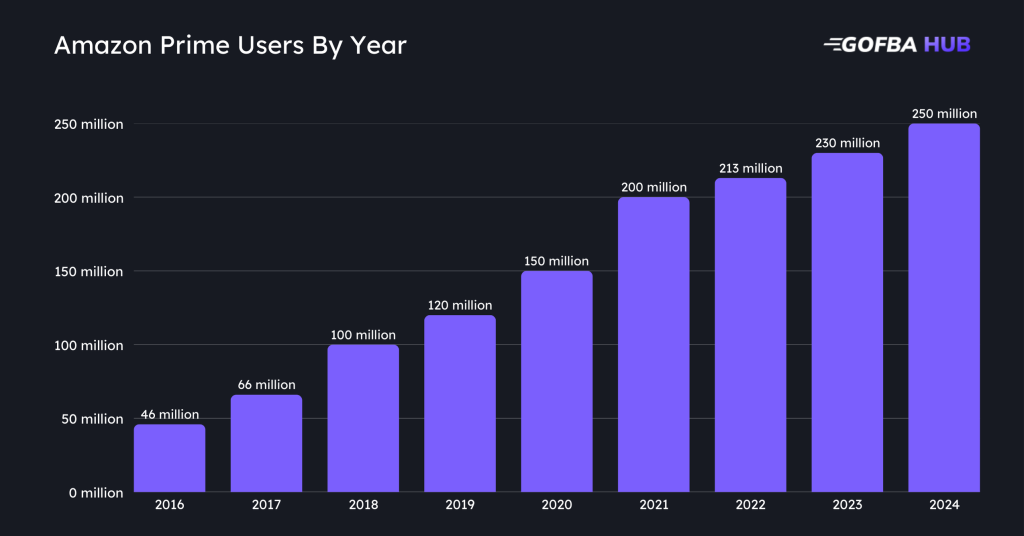
Here is a table displaying the number of Amazon Prime subscribers by year:
| Year | Subscribers |
|---|---|
| 2024 | 250 million |
| 2023 | 230 million |
| 2022 | 213 million |
| 2021 | 200 million |
| 2020 | 150 million |
| 2019 | 120 million |
| 2018 | 100 million |
| 2017 | 66 million |
| 2016 | 46 million |
Sources: Vox, CNBC, Business Of Apps.
In 2024, Amazon Prime reached 181 million subscribers in the U.S., showing a steady increase from 165 million in 2023.
This marks a 16 million rise in just one year. Looking at the bigger picture, the U.S. has seen impressive growth over the years, with the number of subscribers growing from 38 million in 2016 to 181 million in 2024, a solid 376% increase over the 8 years.
The year-to-year growth was particularly noticeable in 2021, when U.S. subscriptions surged by 29 million, likely influenced by the heightened demand for online services during the pandemic. Since then, the growth has continued, but at a more gradual pace, with 13 million new subscribers in 2022 and 7 million more in 2023.
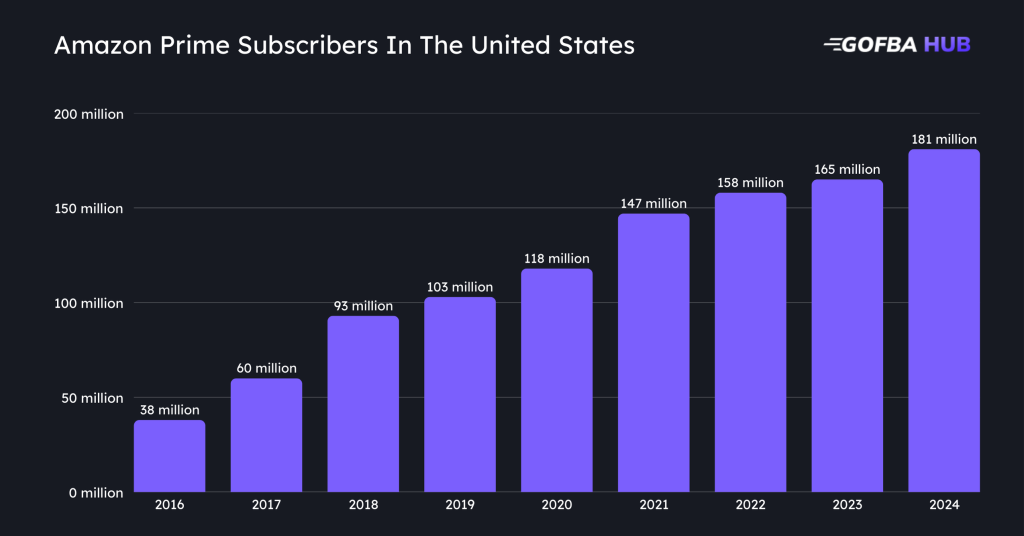
Here is a table displaying the Amazon Prime Subscribers in the United States:
| Year | Subscribers |
|---|---|
| 2024 | 181 million |
| 2023 | 165 million |
| 2022 | 158 million |
| 2021 | 147 million |
| 2020 | 118 million |
| 2019 | 103 million |
| 2018 | 93 million |
| 2017 | 60 million |
| 2016 | 38 million |
Sources: CIRP, Business Of Apps
How many sellers are on Amazon?
Amazon currently has over 9 million registered sellers, and around 2 million are actively selling on the platform.
Each year, about 1 million new sellers join the Amazon marketplace. However, it’s hard to pin down an exact number of active sellers at any given time since the seller base is constantly changing. Some join, some become inactive, and others scale up their operations.
What’s clear is that Amazon continues to grow as a go-to platform for millions of sellers worldwide.
Source: AMZ Scout
In 2024, third-party sellers made up 62% of all sales on Amazon.
That was a noticeable jump from 60% in 2023 and 59% in 2022. This steady climb highlights Amazon’s growing reliance on independent sellers rather than selling its own inventory.
Back in 2021, third-party sellers accounted for 56% of sales, and in 2020, they made up 55%. The trend has been consistent over the years: 53% in 2019, 52% in 2018, and 51% in 2017.
Over the last eight years, the share of third-party sellers has increased by 11 percentage points, rising from 51% in 2017 to 62% in 2024. This shows how Amazon has evolved into a seller-driven marketplace, empowering millions of independent sellers to grow their businesses on its platform.
Source: Statista
Amazon Market Share
In 2023, Amazon clearly led the U.S. e-commerce space, grabbing a huge 37.6% share of the entire online retail market.
To put that into perspective, more than one out of every three dollars spent online in the U.S. went to Amazon. That’s a massive lead compared to other big names. Walmart, the second on the list, held only 6.4%, while Apple followed with 3.6%, and eBay had 3%.
This huge gap shows just how far ahead Amazon is. Its market share is almost six times bigger than Walmart’s and ten times bigger than Apple’s.
Even other popular retailers like Target, Costco, and Best Buy didn’t cross the 2% mark. These numbers make it clear: when it comes to online shopping in the U.S., Amazon is the top choice by a long shot.
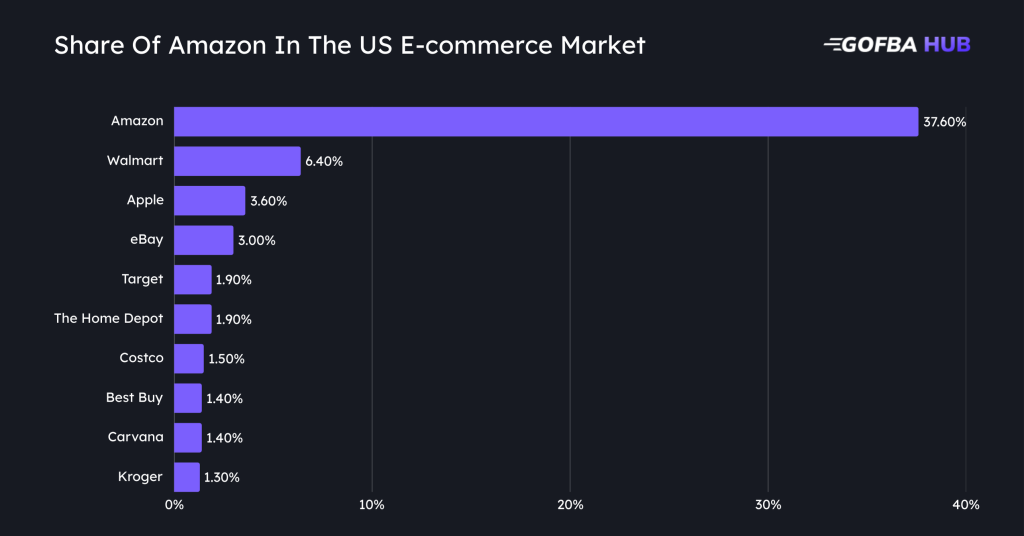
Here is a table displaying the share of Amazon in the US e-commerce market:
| eCommerce Platform | Share of retail e-commerce sales |
|---|---|
| Amazon | 37.6% |
| Walmart | 6.4% |
| Apple | 3.6% |
| eBay | 3% |
| Target | 1.9% |
| The Home Depot | 1.9% |
| Costco | 1.5% |
| Best Buy | 1.4% |
| Carvana | 1.4% |
| Kroger | 1.3% |
Source: Statista
Amazon Revenue
In 2024, Amazon reached a remarkable milestone with a record-breaking revenue of $630 billion, up from $574.9 billion in 2023, an impressive $55.1 billion increase in just one year.
Looking back, the company has shown extraordinary growth over the past two decades. One of the most standout jumps occurred during the pandemic in 2020, when revenue soared from $280.5 billion in 2019 to $386 billion, marking a massive $105.5 billion spike in a single year, driven largely by the global shift to online shopping.
The growth trend continued in 2021, with Amazon hitting $470.8 billion, and later $513.9 billion in 2022. Even as growth slightly stabilized, the company consistently added tens of billions to its revenue annually. Over the last 10 years alone, Amazon’s revenue has grown more than sevenfold, rising from $88.9 billion in 2014 to $630 billion in 2024.
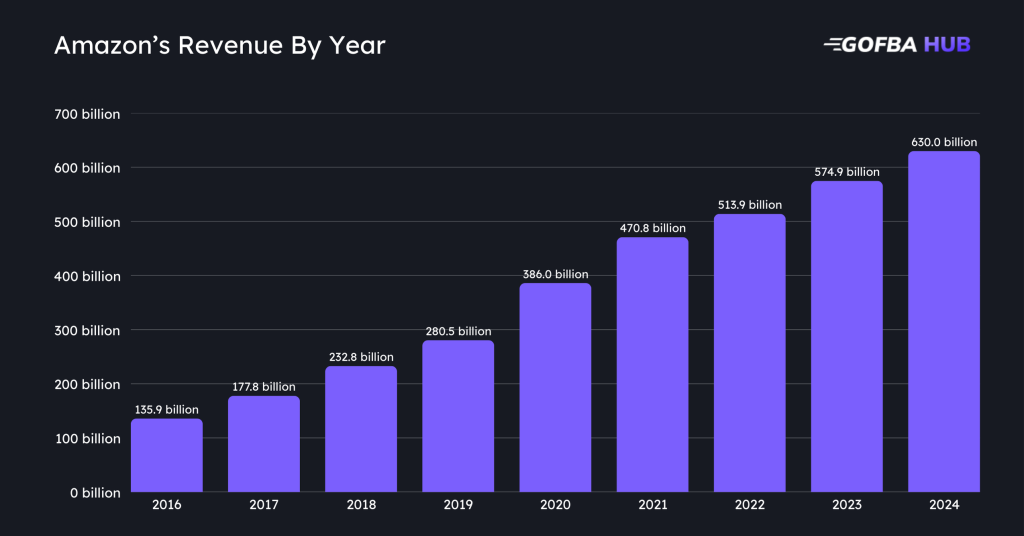
Here is a table displaying Amazon’s revenue recorded over the years:
| Year | Revenue ($) |
|---|---|
| 2024 | 630 billion |
| 2023 | 574.9 billion |
| 2022 | 513.9 billion |
| 2021 | 470.8 billion |
| 2020 | 386 billion |
| 2019 | 280.5 billion |
| 2018 | 232.8 billion |
| 2017 | 177.8 billion |
| 2016 | 135.9 billion |
| 2015 | 107 billion |
| 2014 | 88.9 billion |
| 2013 | 74.4 billion |
| 2012 | 61 billion |
| 2011 | 48 billion |
| 2010 | 34.2 billion |
| 2009 | 24.5 billion |
| 2008 | 19.1 billion |
| 2007 | 14.8 billion |
| 2006 | 10.7 billion |
| 2005 | 8.4 billion |
Source: Amazon, Business Of Apps.
Amazon Profit
In 2024, Amazon hit a huge milestone with $630 billion in revenue, up from $574.9 billion in 2023, an impressive $55.1 billion increase.
This marks the biggest annual jump in recent years, showing that Amazon continues to lead in both e-commerce and cloud services.
One standout year for Amazon’s growth was 2020, when revenue surged from $280.5 billion in 2019 to $386 billion in 2020, a massive $105.5 billion jump, mainly driven by the pandemic and the shift to online shopping.
Looking at the bigger picture, Amazon’s revenue has grown dramatically over the past decade. From 2014 to 2024, its revenue skyrocketed by more than 600%, jumping from $88.9 billion to $630 billion. Even over the last six years, Amazon has nearly tripled its revenue, growing from $232.8 billion in 2018 to $630 billion today, an increase of $397.2 billion.
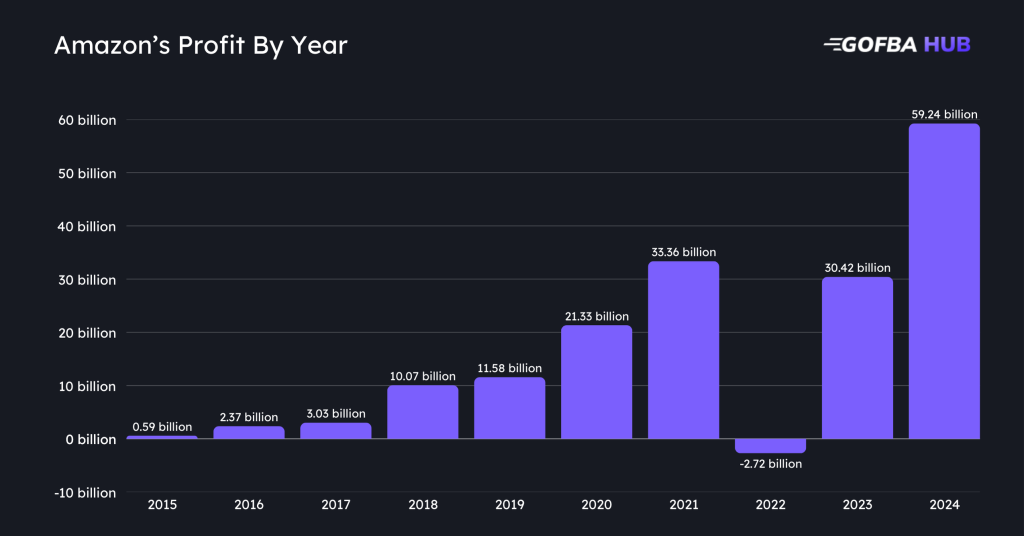
Here is a table displaying Amazon’s revenue in the past year:
| Year | Profit ($) |
|---|---|
| 2024 | 59.24 billion |
| 2023 | 30.42 billion |
| 2022 | -2.72 billion |
| 2021 | 33.36 billion |
| 2020 | 21.33 billion |
| 2019 | 11.58 billion |
| 2018 | 10.07 billion |
| 2017 | 3.03 billion |
| 2016 | 2.37 billion |
| 2015 | 0.59 billion |
| 2014 | -0.24 billion |
| 2013 | -0.27 billion |
| 2012 | -0.03 billion |
| 2011 | 0.63 billion |
| 2010 | 1.15 billion |
| 2009 | 0.9 billion |
| 2008 | 0.64 billion |
| 2007 | 0.47 billion |
| 2006 | 0.19 billion |
| 2005 | 0.35 billion |
Source: Statista, Business Of Apps.
Amazon Prime Statistics
Amazon Prime has become an essential service for millions, offering everything from fast shipping to exclusive video and music content. With a growing number of subscribers worldwide, it continues to shape the way people shop and consume entertainment
Amazon Prime Music Users
As of 2024, Amazon Music boasts approximately 75 million monthly active users, reflecting a steady growth trajectory in recent years.
This expansion is largely attributed to its integration with Amazon Prime, which offers members access to a vast music library as part of their subscription.
In 2023, the platform had around 70 million active users, indicating a 5 million increase over the year 2024. The user base has grown significantly from 16 million in 2018 to 75 million in 2024, nearly a fivefold increase over six years.
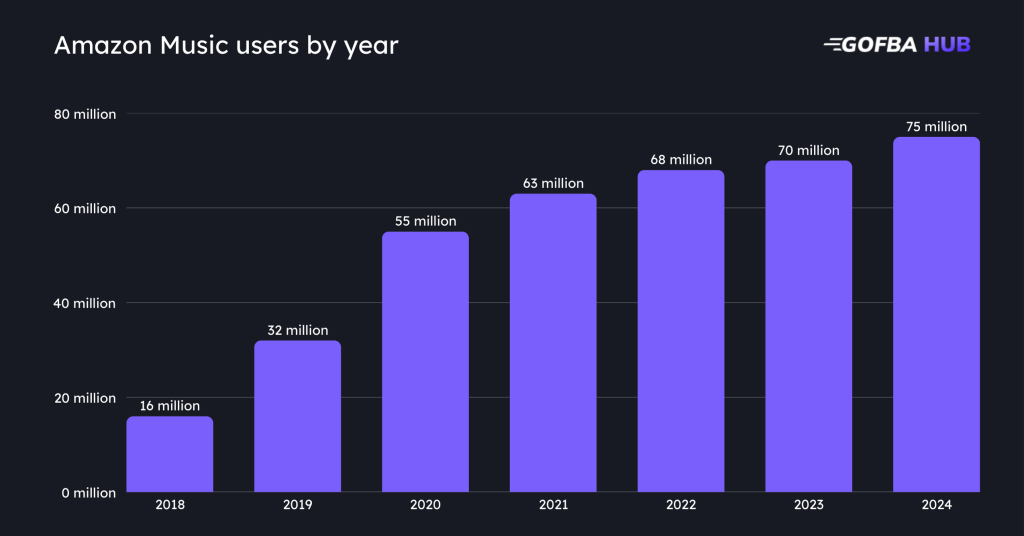
Here is a table displaying the number of Amazon Music users recorded by year:
| Year | Users |
|---|---|
| 2024 | 75 million |
| 2023 | 70 million |
| 2022 | 68 million |
| 2021 | 63 million |
| 2020 | 55 million |
| 2019 | 32 million |
| 2018 | 16 million |
Source: Business Of Apps
Amazon Prime Day Sales
In 2024, Amazon Prime Day hit a new milestone with $14.2 billion in revenue, marking a 10.1% increase from $12.9 billion in 2023.
This continues the steady upward trend seen over the past several years, with consistent single-digit growth from 2021 to 2024.
Between 2020 and 2021, revenue increased by 7.7%, from $10.4 billion to $11.2 billion. Interestingly, 2020 saw a massive 45.3% surge, likely driven by the pandemic-driven online shopping boom.
Back in 2015, the first-ever Prime Day brought in just $0.9 billion. Since then, revenue has grown more than 15-fold, showcasing the explosive success of the event. From 2015 to 2020, double-digit or even high double-digit percentage increases were common.

Here is a table displaying the Amazon Prime Day sales recorded over the years:
| Year | Prime Day Revenue ($) | % Increase from Previous Year |
|---|---|---|
| 2024 | 14.2 billion | 10.1% |
| 2023 | 12.9 billion | 7.5% |
| 2022 | 12.0 billion | 7.1% |
| 2021 | 11.2 billion | 7.7% |
| 2020 | 10.4 billion | 45.3% |
| 2019 | 7.16 billion | 70.9% |
| 2018 | 4.19 billion | 73.9% |
| 2017 | 2.41 billion | 58.6% |
| 2016 | 1.52 billion | 66.7% |
| 2015 | 0.9 billion | – |
Source: Statista
More Stats Like This:
Amazon Employee Statistics
In 2024, Amazon employed approximately 1.56 million people worldwide, marking a slight rise from 1.50 million in 2023.
While this shows a modest growth of around 60,000 employees, it’s still below the peak seen in 2021, when Amazon’s workforce hit 1.60 million, the highest in its history.
Looking back, Amazon’s employee count experienced a massive jump during the pandemic years. In 2020, the number surged to 1.29 million, up from 798,000 in 2019—a dramatic 61.6% increase within a single year. This spike was largely driven by increased demand for online shopping, logistics, and delivery services.
However, the years following 2021 saw slight dips and fluctuations, possibly due to streamlining operations or post-pandemic adjustments. Despite these shifts, Amazon has consistently maintained a workforce of over 1.5 million since 2021, highlighting its position as one of the largest employers globally.
Between 2019 and 2024, Amazon nearly doubled its workforce, adding around 760,000 jobs in just five years.
Here is a table displaying the number of Amazon Employees recorded over the years:
| Year | Number of employees |
|---|---|
| 2024 | 1.56 million |
| 2023 | 1.50 million |
| 2022 | 1.54 million |
| 2021 | 1.60 million |
| 2020 | 1.29 million |
| 2019 | 798,000 |
Source: Statista

